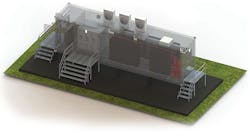EDP Distribuição is taking the first steps to integrate electrical energy storage into a smart grid concept — for a smart storage system. As the main electricity distribution system operator (DSO) in Portugal, EDP Distribuição supplies more than 6 million customers through 400 high-/medium-voltage (HV/MV) substations and 65,000 MV/low-voltage (LV) secondary substations over a network that includes 84,000 km (52,080 miles) of HV/MV networks and 140,000 km (86,996 miles) of LV network.
The evolution of smart grids has been driven mostly by the dual objectives of energy efficiency and operational flexibility, in particular pursuing the ability to manage energy flows across networks with smart metering and automation mechanisms. In this process of distributing intelligence throughout the infrastructure, the logical counterpoint to such operational goals consists of the ability to manage one of the most dynamic interfaces in the electricity sector chain: the customer interface. Some examples of this interface are time-based electricity pricing for the customer (smart pricing); time-shift of consumption promoted by micro- and mini-photovoltaic production and self-consumption; and smart mobility based on electric vehicles, stimulating vehicle-to-grid and grid-to-vehicle interfaces.
The evolution of Portugal’s electricity sector in recent years has been challenging for EDP Distribuição. Subject to privatization and deregulation, the sector currently faces legislative and regulatory changes in foreign trade operations. Furthermore, the proliferation of intermittent renewable energy systems, mini-production and micro-production — and the subsequent bidirectional energy transit and voltage fluctuations — along with growing customer needs and expectations is increasing the need for entirely new and disruptive approaches to grid management. In this context, EDP Distribuição is responsible for ensuring an adequate and reliable power supply to meet society’s needs, while taking into account continuous improvement of controlled risks and costs.
R&D Strategies
To perform the role of facilitator of this dynamic and to be prepared for challenges in the electricity sector requires a constant effort to develop and adopt innovative solutions. EDP Distribuição focuses on coordinating research and development strategies that promote and ensure the testing of new technologies, materials and practices. The DSO also is focused on developing partnerships with universities, scientific research institutes and companies.
Electrical energy storage (EES) is a state-of-the-art topic in the electrical engineering community. Around the world, and particularly in Europe, hundreds of projects are currently under development, based on different technologies and connected to different layers of the electrical system (generation, transmission, distribution and customers).
After taking into consideration the aforementioned needs and trends, EDP Distribuição decided to develop an EES pilot in close integration with its InovGrid project, which aims to provide the electricity network with information and intelligent equipment that can promote the active participation of consumers, integrate distributed generation and electric vehicles, automate network management, improve quality of service, reduce operating costs, promote energy efficiency and environmental sustainability, and also help to reduce national energy dependence.
The EES project’s main objective is to demonstrate how the distributed energy storage concept can contribute to achieve the DSO’s mission of establishing a reliable high-quality energy supply by providing more grid flexibility and the means to a cost-effective and efficient management of the distribution network. The integration of EES in the InovGrid infrastructure and dispatch center will pave the way for implementation of the smart storage system concept.
Pilot Project
To achieve this mission, the pilot project is focused on the utility’s main technical challenges: increase grid reliability, by providing backup to the main load/customer; improve quality of service; and decrease network losses.
The project also provides other network support services such as fault ride-through, voltage control and peak shaving for loss reduction. In the future, the EES system will need to be integrated fully into a higher hierarchical control layer that provides the necessary data to the automation and artificial intelligence of the system, moving toward a smart storage system.
To test the EES system and evaluate its behavior in a controlled environment, EDP Distribuição selected a university campus (Universidade de Évora – Pólo da Mitra) supplied by a minor MV customer. The EES point of common coupling is on the MV side (15 kV) of the 15/0.4-kV secondary substation that supplies the customer.
Despite its stand-alone nature, the system will be connected to EDP Distribuição dispatch center through IEC 60870-104 protocol.
Sizing Methodology
The sizing of the EES system must take into account both power and energy requirements in accordance with the customer’s demand profile. Two criteria were established to evaluate the sizing needs of the system:
• EES energy capacity: 1 hour versus a 30-minute supply
• EES power: maximum annual peak load versus conservative power value.
The sizing requirements of the system were based on the customer’s needs, assessed by the track record of the annual number and duration of outages as well as the customer’s yearly consumption profile. From the outage’s duration analysis, it was possible to conclude EES energy capacity should be sized to 30 minutes, rather than 1 hour, because this option covered approximately 95% of the events.
When analyzing the customer’s consumption profile, it was necessary to take into account the huge difference between the working day and non-working day profile, which represented 49% of the year. This detail is particularly relevant because the EES system will be connected at the end of a capillary region of the distribution network and, therefore, be subject to a significant influence of network losses and load profile variations.
Based on the previous data as well as the link between the customer’s average consumption together with the annual and network outage probabilistic profile, the studies undertaken concluded the best system sizing — taking into consideration EES performance versus investment — was as follows:
•EES power corresponding to the customer’s yearly average power demand plus standard deviation (393 kW)
•EES energy capacity of 30 minutes at rated power (196 kWh).
With these requirements, it is possible to provide backup for 91% to 98% of the time considering a random failure, thus reducing the investment in EES by 11% when compared to full-power backup EES sizing (rated power at the customer’s annual maximum peak load). Furthermore, based on the studies, the average network losses would be reduced by 14.2% in addition to a decrease in overall voltage deviations.
Main Characteristics
In addition to the sizing requirements, EDP Distribuição also concluded the EES system should be able to fulfill the design requirements for a period of 10 years following commissioning. Therefore, battery performance degradation had to be considered.
To assess the predictable system performance degradation, it was necessary to estimate the EES state of charge and depth of discharge, based on failure data analysis. Considering these parameters, along with the system requirements at end of life, overall system losses (8% to 10% for inverters, batteries and transformers) and degradation over time, it was estimated the system had to be oversized as follows:
• EES energy capacity of 360 kWh
• EES power of 472 kW.
Following application of the EES methodology, the Siemens system (now under construction) contains eight lithium battery rack modules, four three-phase inverters coupled with output filters and a three-winding MV/LV transformer. The three-winding transformer (30/15/0.4 kV) allows the connection of the EES system to both 30-kV and 15-kV MV networks to cater for network voltage upgrades or system relocation.
Studies and Simulations
To evaluate its capabilities, the EES system was modeled and a series of real-time simulations were performed by INESC-ID Lisboa in partnership with EDP. Several power flow and peak-shaving simulations were performed to study the EES system on this specific MV network. An average reduction of 15% in the feeder losses is expected and voltage profile deviation also will be improved. However, the main function of the EES system is to provide backup to the customer, thereby limiting the available capacity for auxiliary functions.
Considering this, it will be necessary to develop a control system that prioritizes the grid-support functions. Moreover, the available capacity for network support varies according to the customer’s consumption profile forecast, thus influencing system performance.
The black-start simulation demonstrated the system’s response in case of a MV network supply failure. The system remains in stand-alone operation while stored energy is available and until network supply is restored. Another important system ability is the voltage sag compensation using reactive power injection. According to the performed simulations and considering the EES system’s rated power, it is possible to achieve regular voltage levels with voltage sags up to 13.5% deep.
Ongoing Project
Nonconventional EES systems can effectively contribute to technical goals such as system reliability, power quality and loss reduction. With these objectives in mind, EDP Distribuição began a pilot project on the Portuguese MV network in Évora as part of InovGrid, the DSO’s umbrella smart grid project. The main function of this EES system is to improve power supply reliability. Nevertheless, other benefits can be achieved such as fault ride-through, load peak shaving and voltage regulation. In this pilot, the size of the EES system was designed to meet the specific requirements of its customer; therefore, it was necessary to analyze the customer’s historical consumption profile and to consider the efficiency of the EES system and life-cycle degradation of its components.
This use case will permit the evaluation and attractiveness of electricity storage in terms of technical and economic issues for the DSO to start acquiring knowledge and pave the way for smart storage system implementation.
Moreover, EDP Distribuição is predicting future developments to optimize the EES system. Local functions, such as backup and fault ride-through, can be managed locally. Nonetheless, network management functions, like loss reduction and voltage control, should be managed from the MV feeder point of view, which requires the development of a higher hierarchical level control system that can do the following:
• Forecast the customer’s consumption profile
• Forecast the EES consumption profile of other feeders
• Boost network operation through power flow optimization
• Define EES power-quality set points.
Acknowledgments
The authors would like to acknowledge the EDP Distribuição storage project team; the Siemens team, with special thanks to João Gouveia and Hélio Jesus; as well as the INESC-ID team, namely Professors João Santana, Sónia Ferreira Pinto, Miguel Chaves and Paulo Gambôa.
Pedro Carreira is an electrotechnical engineer in telecommunications at EDP Distribuição, which he joined in 2001 as a telecommunications investment and project manager until his appointment as a member of the innovation and development department. Since 2013, he has been responsible for the innovation and development department at EDP Distribuição, which acts as an enabler of new technologies, developing and testing innovative, pioneering and more efficient technologies.
Ricardo Santos is an electrical engineer who specializes in power systems and project management. From 2007 to 2010, he worked at ABB as a substation protection and control specialist. He joined EDP Distribuição in 2010 working in the physical asset management area. In 2014, he joined the innovation and technology department.
Ricardo Mendes André graduated in electrical engineering specializing in power systems. During 2008 to 2012, he worked for EDP Produção as a contract and project manager. André joined the R&D department in 2012 to promote new technologies in the distribution business. In 2015, he joined the EDP Centre for New Energy Technologies, which focuses on technology demonstration projects.
Gonçalo Faria graduated in electrical engineering specializing in power systems as well as system control and automation. From 2013 until 2014, he worked as an electrical engineer in the electrical business unit at REN, a Portuguese TSO. In 2014, Faria joined the innovation and development department of EDP Distribuição as a project manager.








